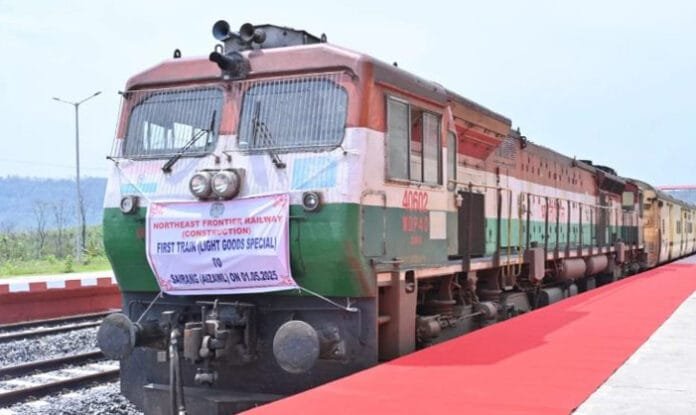In a historic expansion of India’s railway network, Prime Minister Narendra Modi is poised to inaugurate the Bairabi-Sairang railway line, a monumental project that will connect Aizawl, the capital of Mizoram, to the national railway grid for the first time. This comes shortly after the grand inauguration of the Chenab Bridge in Jammu & Kashmir, reinforcing the Modi government’s relentless push to bring connectivity to even the most remote regions.
For over a decade, Indian Railways has been on a mission to bridge gaps left unaddressed by prior administrations. Under PM Modi’s leadership, the once-distant dream of railways in areas like Mizoram, Jammu & Kashmir, and other far-flung states is fast becoming a reality.
Bairabi to Sairang: Engineering Marvel Across 51.38 Kilometers
The 51.38-kilometer-long Bairabi–Sairang rail line is a testimony to India’s engineering prowess and infrastructural commitment. Developed amidst daunting geographical obstacles and logistical bottlenecks, this project will serve as a strategic link connecting Silchar in Assam to Aizawl, carving a new corridor of growth, connectivity, and opportunity in the Northeast region.
This line includes:
48 tunnels stretching a cumulative 12.853 km
55 major and 87 minor bridges
5 road overbridges
9 road underbridges
A bridge towering 104 meters, 42 meters taller than Delhi’s iconic Qutub Minar
These figures are more than numbers—they reflect the intense labor, strategic planning, and cutting-edge technology deployed to penetrate the densely forested and hilly terrain of Mizoram.
Seamless Rail Access to Aizawl: A Dream Realized
The Bairabi–Sairang rail link marks the first-ever rail connection to Aizawl, dramatically reshaping the transportation blueprint of the state. With the Commissioner of Railway Safety (CSR) having granted approval, the final nod for inauguration rests with PM Modi. Once operational, residents of Aizawl will enjoy direct railway access via Silchar, cutting travel time, improving mobility, and enhancing socio-economic exchanges.
Travelers will be able to witness Mizoram’s verdant landscapes, rolling hills, and cultural richness from the comfort of a train—something unimaginable just a decade ago.
Boost to Mizoram’s Tourism, Commerce, and Economy
The new railway line is expected to redefine tourism in Mizoram. Scenic routes, lush forests, hilltop vistas, and tribal villages will now become more accessible. The connectivity surge is set to attract tourists year-round, driving local businesses, hospitality ventures, and tourist-centric startups.
From a commercial perspective, the freight potential is immense. Enhanced rail movement means:
Quicker transportation of agricultural produce
Faster delivery of handicrafts and textiles
Easier access to markets in Assam, Bengal, and beyond
For local entrepreneurs and small businesses near the Sairang railway station, the influx of passengers and cargo offers unprecedented opportunities. Warehousing, logistics services, market stalls, and transport contracts are expected to bloom in tandem with rail traffic.
Strengthening Strategic Connectivity in the Northeast
This railway project is not merely an infrastructure upgrade; it is part of a larger strategic initiative by the Indian government to strengthen the Northeastern region—both economically and in terms of national security.
By connecting border-adjacent states like Mizoram, India solidifies:
Faster mobilization for defense logistics
Improved disaster response mechanisms
Enhanced interstate coordination within the seven-sister states
Such moves echo India’s emphasis on integrated national development and showcase how transportation drives inclusivity and unity.
Employment Generation and Skill Development
The railway line has already created thousands of jobs during its construction phase, engaging engineers, laborers, surveyors, and local artisans. Once functional, the route will require:
Station staff
Signal operators
Track maintenance teams
Security personnel
Vendors and service providers
The Ministry of Railways is also collaborating with local institutions for railway-related vocational training, preparing youth from Mizoram for long-term employment in the rail ecosystem.
Environmental Balance: Sustainable Rail Construction
Building in an ecologically sensitive state like Mizoram demanded environmental mindfulness. The rail line was developed with strict adherence to:
Eco-protection norms
Wildlife clearance protocols
Tunnel boring techniques that minimized tree felling
Use of precast technology to reduce on-site pollution
Several wildlife corridors and rainwater management systems were integrated into the project blueprint, ensuring that infrastructure development does not come at the cost of biodiversity.
A Broader Vision: Connecting India’s Northeast Like Never Before
The Bairabi-Sairang project is part of a larger railway vision for the Northeast, which includes:
Jiribam–Imphal railway in Manipur
Dimapur–Zubza line in Nagaland
Tezpur–Tawang link in Arunachal Pradesh
Sivsagar–Sonari line in Assam
Each project aims to transform isolated regions into vibrant hubs, empowering states long cut off from India’s economic and infrastructural mainstream.
Chenab Bridge & Bairabi-Sairang: Twin Pillars of Rail Expansion
The Chenab Bridge, another jewel in the Modi government’s railway legacy, has already connected Kashmir Valley to the national rail grid. Now, the Bairabi-Sairang line is poised to do the same for Mizoram. These two projects—at opposite ends of the country—underline a pan-India development vision that leaves no state behind.
What Comes Next: Operational Plans and Passenger Services
According to the Northeast Frontier Railway (NFR), passenger services will begin soon after the inauguration. Trains from Silchar to Sairang will likely operate in the initial phase, followed by extensions to major metro routes. Plans are also underway to:
Deploy Vistadome coaches for tourists
Introduce freight corridors for goods traffic
Integrate the line with the upcoming Mizoram Inland Waterways Project
This seamless multimodal connectivity promises to make Aizawl not just a destination—but a transit hub.
Conclusion: A New Era for Northeast India
The Bairabi–Sairang railway line is more than steel rails and concrete tunnels—it is a symbol of hope, progress, and integration. As India celebrates this new chapter in rail expansion, the people of Mizoram stand ready to board the train of development, prosperity, and national unity.
With PM Modi expected to unveil this transformative line soon, Mizoram is no longer at the periphery—it stands at the center of India’s growth journey.

















Hi there,
If internationalnewsandviews.com needs help getting up to $500K in funding, I’d love to help. This is exactly what we do.
Every week we help businesses like Internationalnewsandviews Com get approved for $25K–$500K in funding – even if they’ve been denied before or are unsure if they’ll qualify.
The best part? We make the process simple and quick.
If you’re:
Looking to grow your business,
Consolidate or reconcile debt,
Invest in research and development,
Upgrade equipment or buy new assets…
Then let’s talk.
We’ve helped thousands of clients and have a 4.8-star rating on TrustPilot with hundreds of verified reviews.
Just hit reply to this email and tell me:
That you’re interested, or
A time next week that works for a quick call.
No pressure – just helpful advice and expert guidance to see what’s possible for your situation.
Looking forward to hearing from you,
Velda